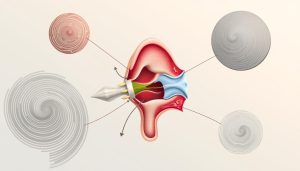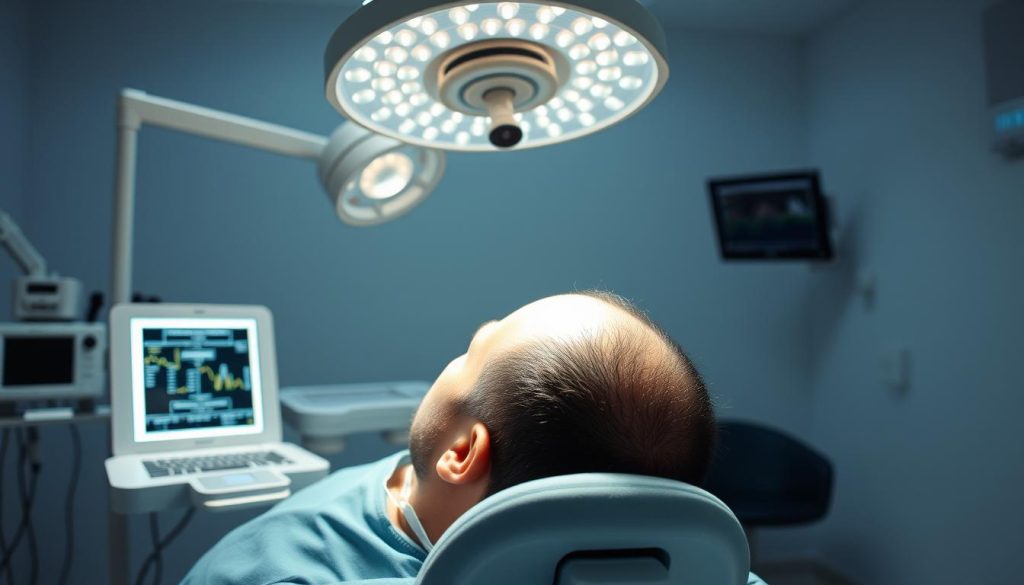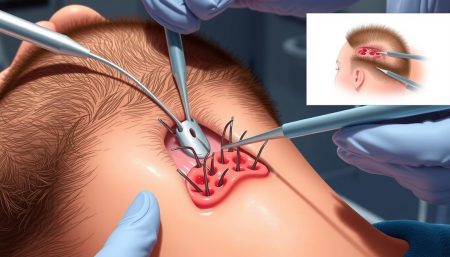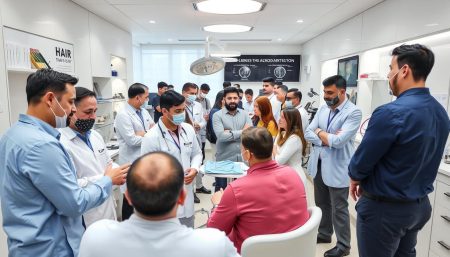Hair loss can be very upsetting. But, modern medicine brings hope. Follicular Unit Transplantation (FUT) is a lasting fix for those wanting to bring back their natural hair. This cutting-edge technique is known for its success in treating different hair loss issues.
FUT hair transplant offers a long-term solution for thinning hair and bald spots. It moves healthy hair follicles from donor areas to thin spots. This way, it creates natural-looking results.
This method’s success comes from its ability to match the original hair pattern. It ensures a smooth blend with the existing hair.
As a long-term solution, FUT does more than just temporary fixes. It boosts confidence and lets people enjoy a full head of hair for years. With its proven success and natural results, FUT is a top choice for reliable hair restoration.
Understanding Follicular Unit Transplantation (FUT)
Follicular unit transplantation (FUT) is a groundbreaking surgical hair transplant method. It has changed the way we deal with hair loss. This technique uses the patient’s own hair follicles for a natural look.
The Science Behind FUT Hair Restoration
FUT takes a strip of hair-bearing scalp from the back of the head. This area is less likely to go bald. The strip is then split into individual follicular units, each with one to four hairs.
These units are carefully placed in thinning or balding spots. They grow in a way that looks natural.
Historical Development of FUT Technique
The FUT method has grown a lot from the 1990s. Surgeons like Dr. Bessam Farjo have made big improvements. They’ve made the procedure more natural and quicker to recover from.
Key Components of the FUT Procedure
A good FUT hair transplant needs a few important things:
- A skilled team led by an experienced surgeon
- Advanced microscopes for graft preparation
- Special tools for grafting
- Careful planning of hairline and graft placement
These elements work together for the best results in hair loss treatment.
Benefits of FUT Hair Transplant
FUT hair transplant is a great solution for those dealing with hair loss. It gives natural-looking results, matching the way hair grows. The way hair follicles are placed makes the new hair blend well with the rest, making it look fuller.
This method has a high success rate. Studies show that the transplanted grafts grow well over time. This makes FUT a top choice for many patients and doctors.
With FUT, you can get a lot of grafts done in one go. This is great for those with a lot of hair loss. It means you might not need to have many surgeries.
| Benefit | Description |
|---|---|
| Natural-looking results | Seamless blend with existing hair |
| High success rate | Excellent graft survival and sustained growth |
| Efficient transplantation | Large number of grafts in a single session |
| Cost-effective | Lower cost per graft compared to other methods |
FUT hair transplant is also more affordable than other options. It’s good for those needing a lot of grafts. Getting many follicles at once can make it cheaper, making it a smart choice for big hair restoration needs.
Ideal Candidates for FUT Hair Restoration
FUT hair restoration is a solution for many with hair loss. It’s a minimally invasive procedure that can change lives. But, not everyone is a good fit. Knowing what makes someone a good candidate helps in choosing the right treatment.
Age and Hair Loss Patterns
FUT works best for those with clear hair loss patterns. Men over 25 with male pattern baldness are often great candidates. Women with female pattern hair loss, where hair thins in certain spots, can also benefit.
Hair and Scalp Characteristics
The quality of donor hair is key for FUT success. You need dense hair in the back and sides of your head. Also, your scalp should be flexible enough for the surgeon to take the donor strip.
- Dense hair in donor area
- Good scalp elasticity
- Contrasting hair and skin colour
Health Requirements
Being in good health is vital for FUT. People with chronic illnesses, blood disorders, or scalp diseases might not be good candidates. Always tell your surgeon about any health issues during your consultation.
“The ideal FUT candidate is someone committed to long-term hair care and realistic about the outcomes of hair restoration.”
Considering these points helps you understand if FUT is for you. The best way to know for sure is to talk to a qualified hair transplant specialist.
The FUT Surgery Process Step by Step
The follicular unit transplantation (FUT) hair transplant is a detailed surgical process. It needs precision and skill. Let’s look at how this technique works step by step.
The journey starts with detailed preparations before surgery. The team marks the donor and recipient areas. They make sure the grafts will be placed perfectly.
Then, local anaesthesia is given to keep the patient comfortable. This is important for the whole procedure.
The key part of FUT is the strip harvesting. A thin strip of scalp is taken from the back of the head. This strip has healthy hair follicles for transplanting.
After harvesting, the team carefully separates the strip into individual follicular units. Each unit has one to four hair follicles. They are ready to be transplanted.
The next step is creating recipient sites in the balding areas. The surgeon makes tiny incisions. They think about the hair growth direction and angle for a natural look.
Then, the grafts are placed into the recipient sites. This step needs a lot of skill and attention. It’s important for a natural look.
Specialised tools are used throughout the surgery. They help with precision and care for the scalp. The whole process can take several hours. It depends on the hair loss and grafts needed.
“FUT hair transplantation is a blend of artistry and science, requiring meticulous attention to detail at every step.”
Understanding the FUT hair transplant process helps patients feel confident. They know they’re on the way to having their hair back and feeling better about themselves.
Recovery and Healing Timeline
The journey to a permanent solution through hair restoration involves a carefully managed recovery process. Understanding the timeline for healing after a FUT hair transplant can help patients prepare for the weeks and months following their procedure.
Immediate Post-operative Care
In the first 24 to 48 hours after the minimally invasive procedure, patients focus on rest and wound care. The scalp may feel tender, and mild swelling is common. Surgeons typically prescribe pain medication and antibiotics to manage discomfort and prevent infection.
Weekly Recovery Milestones
The first week sees the most noticeable changes. Scabs form around the transplanted follicles and gradually fall off. By week two, most patients return to work, though strenuous activities are restricted. Weeks three to four mark the beginning of the ‘shedding phase’, where transplanted hair falls out—a normal part of the process.
Long-term Healing Process
The long-term healing timeline extends over several months. New hair growth typically starts around the third month, with significant improvements visible by the sixth month. Full results of the hair restoration are usually apparent after 12 to 18 months.
| Timeline | Milestone |
|---|---|
| 1-2 days | Rest and initial healing |
| 1-2 weeks | Return to work |
| 3-4 weeks | Shedding phase begins |
| 3 months | New hair growth starts |
| 6 months | Visible improvement |
| 12-18 months | Full results apparent |
Expected Results and Success Rates
FUT hair transplants give natural-looking results and a high success rate. Patients see growth in 3-4 months, and full results in 12-18 months.
The success of FUT comes from choosing and placing hair follicles carefully. Surgeons implant grafts to match the natural hair growth. This ensures the new hair blends well with the existing hair.
“FUT hair transplants can achieve up to 95% graft survival rate when performed by experienced surgeons,” says Dr Sarah Thompson, a leading hair restoration specialist.
Clinical studies show FUT transplants work well over time:
| Time Post-Procedure | Graft Survival Rate | Patient Satisfaction |
|---|---|---|
| 6 months | 85-90% | 75% |
| 12 months | 90-95% | 85% |
| 24 months | 95%+ | 95% |
FUT results last a lifetime. Transplanted hair keeps growing, making it a lasting fix for hair loss. With the right care, patients can enjoy their new hairline for many years.
Comparing FUT vs. Other Hair Restoration Methods
When looking into hair restoration, it’s key to know the differences between methods. Follicular Unit Transplantation (FUT) and Follicular Unit Extraction (FUE) are two main techniques. We’ll look at how they compare in terms of method, cost, and recovery time.
FUT vs. FUE Technique
FUT involves taking a strip of scalp from the donor area. FUE, on the other hand, takes out individual follicles. Both aim for natural-looking hair, but they suit different patients.
| Aspect | FUT | FUE |
|---|---|---|
| Scarring | Linear scar | Tiny dot scars |
| Suitable for | Large areas | Smaller areas |
| Hair length | Can be short | Requires longer hair |
Cost Comparison
Hair restoration costs vary by method. FUT is often cheaper because it’s quicker to get grafts. But, prices change based on the clinic, surgeon, and hair loss extent.
Recovery Time Differences
Recovery times for FUT and FUE are different. FUT needs more time to heal because of the strip removal. FUE heals faster because it’s just tiny sites. Think about these times when picking your method.
Choosing between FUT and other methods depends on your needs, budget, and goals. Talking to a hair transplant expert can help find the best method for you.
Potential Risks and Complications
A surgical hair transplant is usually a safe procedure. But, it’s key to know the possible risks. Dr. Bessam Farjo, a top expert, stresses the need for patients to be aware.
Common side effects include:
- Swelling around the forehead
- Numbness in the donor area
- Mild discomfort during recovery
Less common problems might be infection or scarring. Choosing a skilled surgeon can lower these risks.
- Follow post-operative care instructions carefully
- Go to all follow-up appointments
- Tell your doctor about any odd symptoms right away
Dr. Farjo says, “Most patients face little trouble if they follow the care advice.”
| Complication | Frequency | Prevention Strategy |
|---|---|---|
| Infection | Rare | Strict hygiene protocols |
| Scarring | Uncommon | Skilled surgical technique |
| Swelling | Common | Cold compresses, elevation |
Knowing these risks helps patients make better choices for their hair transplant.
Cost Factors of FUT Hair Transplant
Understanding the costs of a FUT hair transplant is key for those thinking about it. The price can change a lot, depending on several things. It’s important to know all about it.
Basic Procedure Costs
The main cost of a FUT hair transplant is between £3,000 and £15,000. This price change is mainly because of how many grafts you need and how complex your case is. Clinics usually charge per graft, with prices from £2 to £5.
Additional Treatment Expenses
There are extra costs to think about too. These include tests before the surgery, medicines after, and follow-up visits. Some clinics offer deals that include these, which can be a good deal.
Insurance and Financing Options
Most insurance doesn’t cover FUT hair transplants because they’re seen as cosmetic. But, many clinics have financing options to help. These might be payment plans, medical credit cards, or loans for cosmetic treatments.
When looking at the cost of a FUT hair transplant, remember the long-term benefits. It’s a permanent fix for hair loss. The initial cost can save you money in the long run, compared to temporary solutions.
Choosing a Qualified FUT Surgeon
Finding the right surgeon for your hair transplant is key. A skilled expert can greatly improve your chances of success and natural-looking results.
When looking for a qualified FUT surgeon, consider these important factors:
- Board certification in hair restoration
- Years of experience performing FUT procedures
- Before-and-after photos of previous patients
- Patient testimonials and reviews
- Consultation process and communication style
Renowned surgeons like Dr. Bessam Farjo are leaders in the field. Dr. Farjo’s expertise and commitment to new techniques have earned him a great reputation.
To make a good choice, visit several clinics for consultations. Ask about the surgeon’s qualifications, success rates, and FUT procedure approach. Also, see how comfortable you feel with the surgeon and their team.
“Choosing the right surgeon is as important as the procedure itself. A skilled specialist can make all the difference in achieving your desired results.”
Don’t just look for the cheapest option. Focus on skill, experience, and a proven track record of successful FUT surgeries.
| Criteria | Importance |
|---|---|
| Board Certification | Essential |
| Years of Experience | Very Important |
| Before-After Photos | Crucial |
| Patient Reviews | Highly Valuable |
| Consultation Quality | Important |
Post-Transplant Hair Care and Maintenance
Proper care after a FUT hair transplant is key for natural-looking results. It ensures a permanent fix for hair loss. A good maintenance routine greatly affects your hair restoration journey’s success.
Daily Care Routine
After surgery, start a gentle daily care routine. Wash your scalp with lukewarm water and a mild shampoo your surgeon suggests. Don’t rub or scratch the transplanted area. Gently pat dry with a soft towel.
Start gentle brushing after two weeks of healing.
Products and Treatments
Choosing the right products is essential for your new hair. Use special shampoos and conditioners for post-transplant care. These nourish both the transplanted and existing hair follicles.
Adding scalp treatments can boost hair growth and keep your scalp healthy. Minoxidil-based solutions help stimulate hair growth and protect non-transplanted hair.
Long-term Maintenance Strategy
For lasting results, adopt a long-term strategy. This includes:
- Regular check-ups with your hair transplant surgeon
- Eating a balanced diet full of vitamins and minerals
- Protecting your scalp from too much sun
- Avoiding harsh chemical treatments for at least six months after surgery
By sticking to these tips, you can make the most of your FUT hair transplant. Enjoy a fuller, natural-looking head of hair for years.
Recent Advancements in FUT Technology
The field of follicular unit transplantation has seen big changes in recent years. FUT hair transplant procedures are now more efficient and kinder to patients. They use the latest technologies to improve results.
One big step forward is the creation of automated graft harvesting systems. These tools make extracting grafts faster and reduce damage. This makes FUT a less invasive procedure, leading to quicker recovery times for patients.
New graft preservation techniques have also been developed. Advanced storage solutions keep hair follicles alive for longer. This allows for more flexible scheduling and potentially better transplant outcomes.
The use of high-powered microscopes and precise instruments has changed graft placement. Surgeons can now make hairlines look more natural with greater accuracy. This addresses a common worry among FUT patients.
| Advancement | Benefit |
|---|---|
| Automated harvesting | Reduced surgery time, minimised graft damage |
| Improved preservation | Extended graft viability, flexible scheduling |
| Precision instruments | More natural-looking results |
These technological advancements have greatly improved the FUT hair transplant experience. As research goes on, we can look forward to even more innovations. These will make this effective hair restoration method even better.
Patient Testimonials and Success Stories
Real-life stories show how effective FUT hair transplantation is. Many patients have shared their experiences. They talk about the natural-looking results they got from this treatment.
Before-and-after photos tell a powerful story. Patients are amazed at how their new hair looks. It blends perfectly with their existing hair, making them look fuller and younger.
FUT has changed more than just their hair. It has boosted their confidence and improved their social lives. One patient said, “I no longer shy away from photos or worry about windy days. My natural-looking results have given me a new lease on life.” These stories highlight the life-changing impact of FUT hair transplantation.
FAQ
Q: What is a FUT hair transplant?
A: A FUT hair transplant is a surgery that moves hair from the back of your head to bald spots. It’s a way to restore hair permanently. This method makes your hair look natural.
Q: How long does a FUT hair transplant procedure take?
A: A FUT transplant can take 4 to 8 hours. This depends on how many grafts you need. Sometimes, you might need more than one session.
Q: Is FUT hair transplantation painful?
A: No, you won’t feel pain during the surgery because it’s done under local anaesthesia. You might feel some soreness later, but this can be managed with medicine.
Q: How long is the recovery period after a FUT hair transplant?
A: You can go back to work in 7-10 days. But, it takes a few weeks for the scar to fully heal. Make sure to follow your surgeon’s care instructions.
Q: When will I see results from my FUT hair transplant?
A: You’ll start seeing results in 3-4 months. But, it takes 12-18 months to see the full effect. The hair will keep growing for life.
Q: Are there any risks or complications associated with FUT hair transplantation?
A: FUT is mostly safe, but there are risks like infection and scarring. Choosing a skilled surgeon like Dr. Bessam Farjo can lower these risks. Talk about possible complications with your surgeon.
Q: How does FUT compare to other hair restoration methods?
A: FUT is good for big hair loss because it can do many grafts at once. It might give more grafts than FUE. But, it leaves a scar that might show with short hair.
Q: What factors determine the cost of a FUT hair transplant?
A: The cost depends on grafts needed, surgeon’s skill, and clinic location. You might also pay for tests, medicine, and follow-up visits. Discuss the cost with your surgeon.
Q: How do I choose a qualified FUT surgeon?
A: Look for a board-certified surgeon with lots of experience. Dr. Bessam Farjo is known for great results. Have a detailed consultation to make sure they meet your needs.
Q: How should I care for my transplanted hair after the procedure?
A: Follow a special washing routine and avoid direct sunlight. Don’t do too much for a few weeks. Use the medicine your surgeon gives you. They’ll tell you how to care for your hair long-term.


















